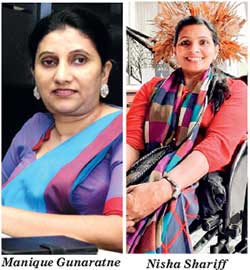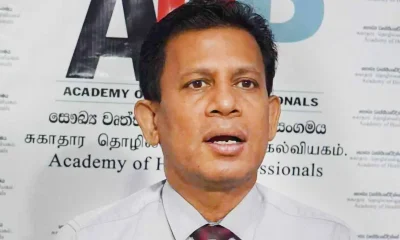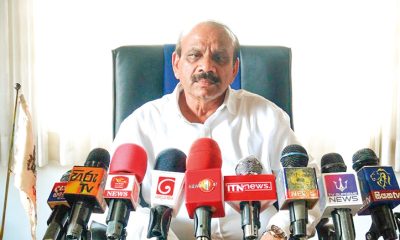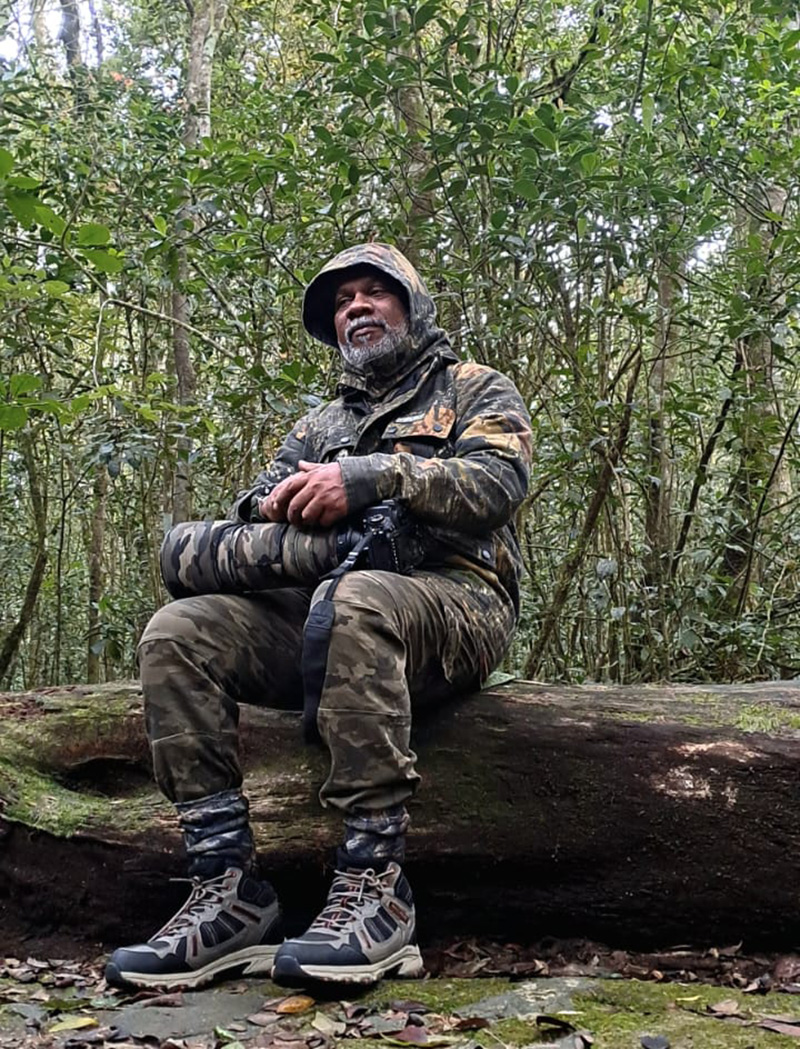Life style
Leaving no woman behind

As International Women’s Day falls tomorrow (March 8), we spoke to several trendsetting women whose physical disabilities have not dampened their spirits but spurred them to overcome their challenges. These courageous women urge all fellow Lankan women to join hands with them in a journey of empowerment.
by Randima Attygalle
“I gained knowledge with my ‘Head’, skills with my ‘Hands’ and developed good attitudes with my ‘Heart”, says Manique Gunaratne, Manager, Specialized Training and Disability Resource Centre of the Employers’ Federation of Ceylon (EFC). The vision impaired internationally renowned advocate’s words echo poet Maya Angelou’s words of inspiration, ‘a wise woman wishes to be no one’s enemy; a wise woman refuses to be anyone’s victim.’ Manique who lost her vision in her late twenties to Retinitis Pigmentosa is today a committed leader improving the lives of persons with disabilities. A highly skilled ICT professional who trains people with disabilities to be IT- savvy, her efforts to enhance the quality of lives of such people have been recognized by various global platforms to be having a significant impact on inclusive economic development as well.
Driving the EFC’s Specialized Training and Disability Resource Centre which rests on the concept of ‘nothing about us without us,’ Manique translates it to all her efforts in empowering women and men with disabilities to be independent in society. “I’m really happy about who I am today. As a woman with a disability I was able to reach the top professionally. Today I’m committed to empower my fellow women, so that they can also enjoy a leadership role.”
 Working strongly on the ‘5-Ds’ is her success, says Manique who urges all women to take a cue from her mantra to overcome challenges. “Dream- Desire- Determination-Dedication and Discipline’ can do wonders,” she reflects. Women without disability can play a huge role in joining hands with women with disability to become proactive partners of a journey together, she believes. “Always include women with disabilities in all your agendas because they are part of you.” She goes on to note that women with disabilities should also be included in all policy-making committees and task forces. “Even the National Committee for Women does not have a single woman with a disability. We need to change this trend,” she says.
Working strongly on the ‘5-Ds’ is her success, says Manique who urges all women to take a cue from her mantra to overcome challenges. “Dream- Desire- Determination-Dedication and Discipline’ can do wonders,” she reflects. Women without disability can play a huge role in joining hands with women with disability to become proactive partners of a journey together, she believes. “Always include women with disabilities in all your agendas because they are part of you.” She goes on to note that women with disabilities should also be included in all policy-making committees and task forces. “Even the National Committee for Women does not have a single woman with a disability. We need to change this trend,” she says.
Self pity is our worst enemy, and if we yield to it, we can never do anything wise in this world,
said Hellen Keller, the American author and disability rights activist. Inspired by these words, Vasantha Padmini from Ambalangoda has turned adversity into opportunity. Vision impaired from birth, Vasantha, 53, a mother of three, is a professional Hindi translator and a gifted musician. She has translated nearly 15 books of reputed Indian authors to Sinhala. A lover of Latha Mangeshkar, Asha Bhosle and Mohammed Rafi, Vasantha sings and plays the violin.
With bare minimum resources both as a schoolgirl and later as an undergraduate at the Kelaniya University where she read Hindi, Sinhala and Translation Methods, Vasantha lobbies for wider study material in Braille both at school and university. “Every vision impaired person should be able to access all his/her subjects of choice in Braille,” says Vasantha recounting her student days experience of learning with the help of her mother and friends who used to read the notes out to her. Her determination to master Hindi at the university with just a handful of Braille material offers inspiration to many who would easily abandon their dreams.
Vasantha who became a visiting lecturer of Hindi at the Kelaniya University was fortunate to see her younger daughter following her footsteps. “Although I could not become a full-time lecturer due to my disability, my daughter completed my dream for me by becoming a Hindi lecturer. My elder daughter is a teacher and my son runs his own business,” beams Vasantha.
A woman who believes that learning transcends age, she is now learning the ropes of the ‘virtual world’. She is constantly updating her knowledge with the help of the on-line Braille material. “Keeping one’s mind engaged helps to overcome physical disability,” says this gritty woman who is working on several translations. She met her future husband when she was teaching music at the Batapola Central College and has proven herself a successful wife and a mother. Her husband and three children, all blessed with vision, make her world complete. “However, not everyone with a disability is as fortunate as I,” reflects this multi-talented woman who is vocal about the rights of the less fortunate. “Life is unpredictable, anyone can become disabled at any time, hence women without disability should be more sensitive to the needs of the disabled. What is required is not sympathy but empowerment so that their sisters could become equal partners contributing to national development.”
Time has certainly made watch-mending Nisha Shariff from Kandy a resilient woman. A wheelchair user, Nisha runs her watch repair business in the Kandy town. Having learned the trade at the Ragama Rehabilitation Centre, Nisha strives to share her knowledge by mentoring others. “There is still no other vocational centre which trains people to repair watches despite this being an essential service. If any such centre is willing to use my skills, I’ll be more than happy to share because this is a skill which can easily be acquired by especially those with disability,” smiles Nisha. She has her own loyal customers whose first impressions of her is quite amusing. “First question they ask me is where my husband is, assuming I’m only an assistant. When I say I have no husband and I run the shop, they are quite impressed,” she chuckles.
Having set up We for Rights, an organization dedicated to the cause of those with disabilities, Nisha’s ultimate dream is to see it expanding across the island. Having learnt the alphabet only at 18, she reads and writes Sinhala well. She is also fluent in Tamil. A woman ever willing to challenge herself, Nisha is self-studying English with the help of online teaching material. Her latest challenge is teaching watch mending to a young boy with an intellectual disability. “He has progressed considerably,” beams Nisha.
An activist who labours to galvanize like-minded men and women to empower those with disabilities and help them to stand on their own feet, Nisha is critical about discrimination at every level. “Very often women with disabilities are treated only as exhibits; policies are made for us without our voices being heard. It is very sad that even on Women’s Day, there is hardly national level representation of women in our predicament. We are confined largely to Social Services which should not be the case because we are active partners in the economy and our expertise should be made use of at every level.”
An accident in Germany where she worked 17 years ago paralyzed Nelum Perera. Wheelchair bound, she sought refuge in art. “I’ve always been good at drawing but I never pursued it seriously. It was only after my accident, and when I was 50, that I started learning art professionally,” recollects Nelum who works with both acrylic on canvas and water colours. Lack of disable-friendly toilet facilities is one of the main bottlenecks which prevents her from exhibiting her work at leading art exhibitions in the country. “I’m often pushed to become only a spectator at these exhibitions as there is no suitable infrastructure for people like us to sell our work at open fairs,” says Nelum. She also finds it difficult to source her art material due to high prices. “I’d be grateful to anyone who can visit me and purchase my work or help find potential buyers,” adds the artist.

Life style
What I Do, What I Love: A Life Shaped by Art, Wilderness and Truth

In a country where creative pursuits are often treated as indulgences rather than vocations, Saman Halloluwa’s journey stands apart — carved patiently through brushstrokes, framed through a camera lens, and articulated through the written word. Painter, wildlife and nature photographer, and independent environmental journalist, Halloluwa inhabits a rare space where art, ecology and social responsibility converge.
His relationship with art began not in galleries or exhibitions, but in a classroom. From his school days, drawing was not simply a subject but an instinct — a language through which he learned to observe, interpret and respond to the world around him. Under the guidance of two dedicated mentors, Ariyaratne Guru Mahathaya and Gunathilaka Guru Mahathaya, he honed both skill and discipline. Those early lessons laid the foundation for a lifelong engagement with visual storytelling.

“His work navigates between traditional Sinhala artistic sensibilities, abstract compositions and expansive landscapes.”
 That commitment eventually materialised in two solo art exhibitions. The first, held in 2012, marked his formal entry into Sri Lanka’s art scene. The second, staged in Colombo in 2024, was a more mature statement — both in content and confidence. Featuring nearly fifty paintings, the exhibition drew an encouraging public response and reaffirmed his place as an artist with a distinct visual voice.
That commitment eventually materialised in two solo art exhibitions. The first, held in 2012, marked his formal entry into Sri Lanka’s art scene. The second, staged in Colombo in 2024, was a more mature statement — both in content and confidence. Featuring nearly fifty paintings, the exhibition drew an encouraging public response and reaffirmed his place as an artist with a distinct visual voice.
His work navigates between traditional Sinhala artistic sensibilities, abstract compositions and expansive landscapes. There is restraint in his use of form and colour, and an underlying dialogue between memory and space. Yet, despite positive reception, Halloluwa speaks candidly about the structural challenges faced by artists in Sri Lanka. Recognition remains limited; fair valuation even rarer.
“This is not merely an artistic issue,” he observes. “It is a social and economic problem.”
In Sri Lanka, art is often viewed through the lens of affordability rather than artistic merit. Many approach a painting by first calculating the contents of their wallet, not the value of the idea or labour behind it. In contrast, he notes, art in Europe and many other regions is treated as cultural capital — an investment in identity, history and thought. Until this mindset shifts, local artists will continue to struggle for sustainability.
The decisive push toward wildlife photography came from Professor Pujitha Wickramasinghe, a close friend who recognised both Halloluwa’s observational skills and his affinity with nature. From there, the journey deepened under the mentorship of senior wildlife photographer Ravindra Siriwardena.
Both mentors, he insists, deserve acknowledgment not merely as teachers but as ethical compasses. In a field increasingly driven by competition and spectacle, such grounding is invaluable.
Wildlife photography, Halloluwa argues, is among the most demanding visual disciplines. It cannot be improvised or rushed. “This is an art that demands restraint,” he says.
Among all subjects, elephants hold a special place in his work. Photographing elephants is not merely about proximity or scale, but about understanding behaviour. Observing social patterns, movement, mood and interaction transforms elephant photography into a constantly evolving challenge. It is precisely this complexity that draws him repeatedly to them.
Halloluwa is cautiously optimistic about the current surge of interest in wildlife photography among Sri Lankan youth. Opportunities have expanded, with local and international competitions, exhibitions and platforms becoming more accessible. However, he issues a clear warning: passion alone is not enough
Sri Lanka, he believes, is uniquely positioned in the global nature photography landscape. Few countries offer such concentrated biodiversity within a compact geographical area. This privilege, however, carries responsibility. Nature photography should not merely aestheticise wildlife, but foster respect, aware ness and conservation.
Parallel to his visual work runs another equally significant pursuit — environmental journalism. For the past seven to eight years, Halloluwa has worked as an independent environmental journalist, giving voice to ecological issues often sidelined in mainstream discourse. His entry into the field was guided by Thusara Gunaratne, whose encouragement he acknowledges with gratitude.
An old boy of D.S. Senanayake College, Colombo, Halloluwa holds a Diploma in Writing and Journalism from the University of Sri Jayewardenepura and has completed journalism studies at the Sri Lanka Press Institute. He is currently pursuing an Advanced Certificate in Wildlife Management and Conservation at the Open University of Sri Lanka — a testament to his belief that learning must remain continuous, especially in a rapidly changing ecological landscape.
Outside his professional life, he enjoys cricket, rugby and badminton. Yet even leisure intersects with responsibility. He is a founding member and former president of the D.S. Senanayake College Old Boys’ Wildlife Forum, an active member of Wild Tuskers Sri Lanka, and a contributor to several independent environmental and wildlife volunteer organisations. In an era dominated by speed, spectacle and short attention spans, Saman Halloluwa’s journey unfolds differently. It is deliberate, reflective and rooted in values. Through art, he captures memory and form. Through photography, he frames life beyond human control. Through journalism, he asks uncomfortable but necessary questions.
“What I do, what I love” is not fashion here.
It is conviction — patiently lived, quietly asserted, and urgently needed in a country still learning how to value its artists, its environment and its truth.
By Ifham Nizam ✍️
Life style
Shaping the future of style

Ramani Fernando Sunsilk Hair and Beauty Academy
Ramani Fernando Sunsilk Hair and Beauty Academy marked their graduation of their latest cohort of aspiring hair professionals in a ceremony held at Kingsbury Hotel.
For over two decades, the Ramani Fernando Sunsilk Hair and Beauty Academy has stood as a beacon of excellence in beauty education in Sri Lanka. Founded by industry icon Ramani Fernando, the Academy has built a reputation for producing highly skilled professionals who go on to make their mark in salons, both locally and internationally. As the newly minted graduates step out into the world, they carry forward not just certificates, but also the promise of creative authority and personal empowerment.
The chief guest for the occasion was Rosy Senanayake, a long-standing supporter of the Academy’s mission. Addressing the graduates her message echoed her enduring belief that the beauty industry is not merely about aesthetic but about. confidence, self-worth and future leaders.
Over months of rigorous training, these young professionals honed their skills in cutting colouring, styling and contemporary artistry readying themselves to set trends rather than follow them.
Each graduate walked the stage with confidence, their dedication signalling a promising future for Sri Lanka’s beauty and fashion industry! With this new generation of stylists preparing to raise the standard of professional hairstyling.
Ramani Fernando, addressing the audience reflected on the academy’s mission to cultivate not only skills but vision and confidence in every student.
She urged the graduates to embrace continuous learning to take risks with creativity .The world of beauty is ever evolving, stay curious, stay bold and never underestimate the power of your talent, she added emphasising the importance of confidence, discipline and passion in carving a successful career in shaping the future of style.
These graduates are stepping into a world of endless possibilities. They are future of the country, who will carry a forward legacy of creativity. Behind every successful graduate at Sun silk Hair Academy stands a team dedicated to excellence. While Ramani Fernando serves as a visionary Principal and it is Lucky Lenagala, her trusted person who ensures that the academy runs seemingly.
From overseeing training sessions to guiding students, through hands on practice, Lucky plays a pivotal role in shaping the next generation of hairstylists.
Kumara de Silva, who has been the official compere Ramani’s, Hair graduation ceremony, from inception has brought energy, poise and professionalism. The Sunsilk Hair Academy is a celebration of talent and mentor ship for the graduates stepping confidentially into the next chapter of their careers, ready to make their mark on Sri Lanka beauty landscape
Pix by Thushara Attapathu
By Zanita Careem ✍️
Life style
Capturing the spirit of Christmas

During this season, Romesh Atapattu’s Capello Salon buzzes with a unique energy – a blend of festive excitement and elegance. Clients arrive with visions of holiday parties, office soirees, seeking looks that capture both glamour and individuality. The salon itself mirrors this celebrity mood. Warm lights, tasteful festive décor create an atmosphere where beauty and confidence flourish.
Romesh Atapattu himself curates the festive décor, infusing the space with his signature sense of style. His personal eye ensures that the décor complements the salon’s modern interiors.
As Colombo slips effortlessly into its most glamorous time of year, the Christmas season brings with it more than twinkling lights and celebrity soirees – it signals a transformation season at salons across the city. Capello salons are no exception.
At the heart of this festive beauty movement is Romesh Atapattu of Capello salons, a name synonymous with refined hair artistry, modern elegance and personalised style.
Christmas is about confidence and celebration. Romesh believes ‘People want to look their best without losing who they are”. Our role is to enhance, not overpower. This philosophy is evident in the salon’s seasonal approach.
Beyond trends, what sets Atapattu apart is the attention to individuality. Each consultation is treated as a creative collaboration – face shape, lifestyle, hair texture and personal style all play a role in creating the best for Romesh.
Stepping into Romesh’s salon during the Christmas season is an experience in itself. The space hums with festive energy while maintaining an atmosphere of calm sophistication.
The décor embraces the Christmas spirit with understated elegance. Tastefully adorned décor, beautiful Xmas tree, soft gold and ivory tones, and gentle hints of red are woven seamlessly into the salon’s contemporary design.
His staff, known for their warmth and professionalism also plays a key role in shaping the salon’s atmosphere—friendly, stylish and always welcoming. The Capello staff combine skill and creativity to deliver results that have a lasting impression.
Beyond trends, what sets Romesh Atapattu apart is the attention to individuality. Each consultation is treated as a creative collaboration – face shape, lifestyle, hair texture and personal style all play a role.
He is a professional who blends technical mastery with a deeply personal approach to style. His dedicated team of skilled professionals, operate with quiet confidence ensuring styles that create an atmosphere of trust, turning every appointment into a personalised and memorable experience.
(ZC) ✍️
Pic by Rohan Herath
-

 News6 days ago
News6 days agoMembers of Lankan Community in Washington D.C. donates to ‘Rebuilding Sri Lanka’ Flood Relief Fund
-

 News4 days ago
News4 days agoBritish MP calls on Foreign Secretary to expand sanction package against ‘Sri Lankan war criminals’
-

 Features6 days ago
Features6 days agoGeneral education reforms: What about language and ethnicity?
-

 News6 days ago
News6 days agoSuspension of Indian drug part of cover-up by NMRA: Academy of Health Professionals
-

 Sports4 days ago
Sports4 days agoChief selector’s remarks disappointing says Mickey Arthur
-

 News3 days ago
News3 days agoStreet vendors banned from Kandy City
-

 Editorial6 days ago
Editorial6 days agoA very sad day for the rule of law
-

 News6 days ago
News6 days agoUS Ambassador to Sri Lanka among 29 career diplomats recalled



















